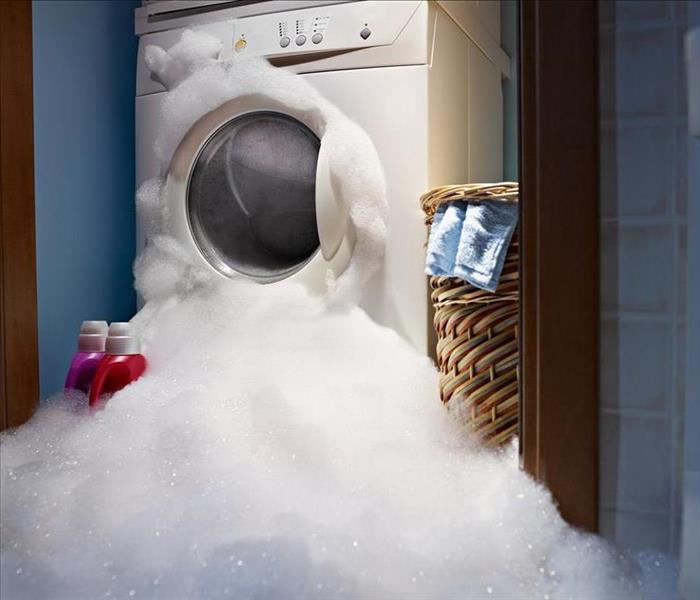Who Can I Call to Clean Up a Washing Machine Overflow?
7/22/2020 (Permalink)
 Surprise Water Damage in Buffalo Grove? We Cannot Fix the Washing Machine, but We Can Restore Your Home, "Like it never even happened."
Surprise Water Damage in Buffalo Grove? We Cannot Fix the Washing Machine, but We Can Restore Your Home, "Like it never even happened."
Licensed Technicians Perform Water Cleanup to Return Buffalo Grove Homes to Their Pre-Loss States
Whether they are caused by using too much detergent or mechanical failures, washing machine overflows have the potential to create significant amounts of water damage in a short time. Professional mitigation can ensure that the loss does not have long-term effects on the safety and structural integrity of your Buffalo Grove property.
If you need water cleanup services for your Buffalo Grove home, SERVPRO technicians are licensed to provide water damage mitigation and restoration for residential applications. This team undergoes extensive training and education in restoration industry standards per the Institution of Inspection Cleaning and Restoration Certification (IICRC) to provide a consistently high standard of cleanup that combines tried-and-true techniques with proprietary sanitation solutions and sophisticated technologies.
How Do Washing Machine Overflows Occur?
Whether you are a Buffalo Grove homeowner with a top- or front-loading washing machine, these appliances share many of the same common issues to take into account, such as:
- Defective water inlet valves. A damaged water inlet valve is easily detected by shutting off power to your machine while the tub is filling with water. If your washer continues to fill with water, the water inlet valve is the most likely culprit.
- Faulty pressure switches. These switches turn off the inlet valve once sufficient water levels are achieved for cleaning. However, if the switch fails, the tub can continue to fill with water. The air tube connected to the pressure switch may also be clogged.
- Decreased water pressure. Sometimes low water pressure can create water damage. Most washer inlet valves need a minimum of 20 psi to shut off water correctly. Too little water pressure can make the valve not close fully.
What are the “Dos and Don’ts” of Home Water Cleanup?
While SERVPRO is available day and night to mitigate water damage, there are some steps Buffalo Grove homeowners can take to mitigate damage to their properties:
- Do call your insurance provider to file a claim as soon as possible. The sooner you file, the more quickly you can be compensated for damages to your home and belongings.
- Do not remove water-damaged items from your home until an insurance adjuster has had a chance to evaluate them. Moving or removing these items from the location where the damage occurred can affect the compensation you receive from your insurer.
- Do mop up clean water caused by a leak, spill, or overflow to prevent moisture damage from affecting drywall, flooring, carpet, pad, and subflooring, among other surfaces.
- Do not operate electronics in water-damaged areas, especially if it seems likely that water has affected outlets, electrical wiring, or circuit breakers. Doing so can increase the risk of both electrical shocks and appliance failure.
- Do contact your utility provider if you need assistance shutting off your water or finding the water main. This step is essential if the source of the damage is in your plumbing.
- Do not operate fans and consumer-grade dehumidifiers and expect it to mitigate water damage fully. Structural drying without commercial-grade moisture extraction tools can be quite time-consuming and even create secondary water damages to your structure. Increased air movement in a humid space can also increase the likelihood of spreading microbes and mold spores through the air.
How Does SERVPRO Detect Water Damage on My Property?
SERVPRO crews have access to a wide variety of moisture detection tools that work for an equally diverse array of surfaces. Successful water damage cleanup relies on accurate moisture level measurement to determine a drying plan that restores surfaces to normal humidity levels.
Measurement apparatuses available to technicians include:
- Moisture sensors designed to detect the moisture content of carpet and pad. This tool can aid in indicating whether water damage has reached the subfloor, but is tailored toward determining the presence of moisture, not measuring the amount of moisture affecting a surface.
- Moisture meters, on the other hand, determine the moisture content of measured surfaces. Some meters are calibrated to measure specific surfaces, like wood or drywall. General-use moisture meters are typically calibrated for wood by default, with measurements ranging from 5% to 30%.
- Thermo-hygrometers, which measure the relative humidity and temperature of the air, as well as:
- Humidity ratios
- Vapor pressure
- Dew point
Technicians use hygrometers to compare relative humidity in affected and unaffected areas, as well as outdoor air, air passed through dehumidifiers, and the air emitted by HVAC systems.
- Thermal imaging cameras are designed to detect moisture in building materials such as wood, drywall, and insulation. Technicians use infrared imaging to quickly ascertain the extent of water damage in a structure by examining temperature differences in surfaces that are likely caused by moisture exposure.
SERVPRO of Buffalo Grove / Lake Zurich provides cleanup and restoration services that are Faster to Any Size Disaster when you call (847) 279-1940.






 24/7 Emergency Service
24/7 Emergency Service